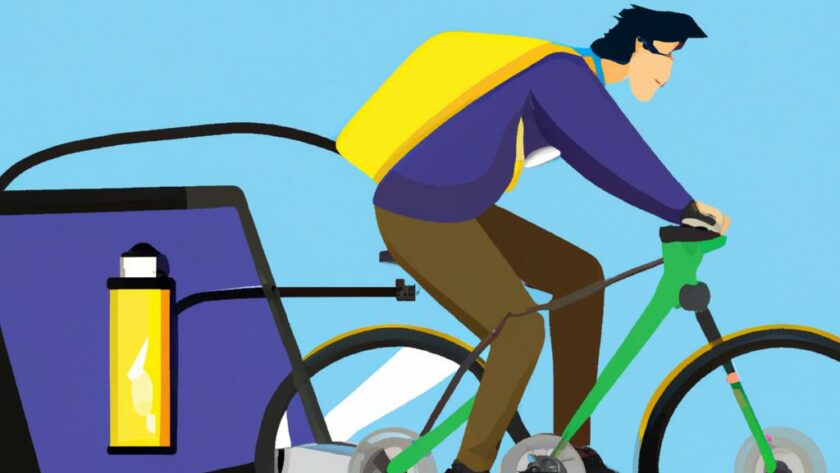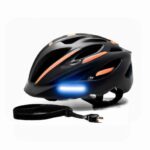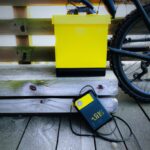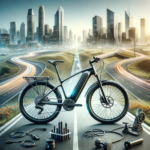Introduction to electric bikes and wattage
Electric bikes have become quite popular these days thanks to their power, reliability and ease of use. They differ from traditional bikes by using various electrical components including motors, rechargeable batteries and other digital displays to allow for more efficient movement on the road
One of the key elements to consider when picking an electric bike is wattage which refers to the amount of energy required to create an electrically-powered cycle. Like any technical things, it can be a bit daunting at first but fortunately when it comes to wattage, it’s not overly complex.
- Think of wattage like the fuel for your e-bike – you’ll want the right amount for your chosen needs.
- So, what should you know about wattage before deciding on an electric bike? Well, in order to answer that question, it’s first important to understand the basic components of an e-bike.
Understanding the Basic Components of an E-bike
If you’re new to the world of electric bikes, it’s important to familiarize yourself with the basic components that make up these machines. Here are the key parts you’ll need to know:
- Battery: This is the power source of your electric bike and comes in different capacities, voltage ratings, and shapes.
- Motor: It’s the heart of your e-bike that converts electricity into mechanical power to help propel the bike forward. The size and location of the motor can vary depending on the e-bike model.
- Sensor: Most e-bikes have a speed sensor and a pedal-assist sensor, and these detect your pedalling speed and determine the amount of assistance the motor will provide.
- Controller: This component manages the flow of electricity from the battery to the motor, decides the level of assistance you get from the motor, and helps communicate data about the bike’s performance to you through the display panel.
- Display Panel: This lets you monitor essential information like battery life, speed, distance travelled, and your selected riding mode. The layout and navigational features of display panels can differ among e-bike models.
- Brakes: These are essential for safety and come in two main types – mechanical and hydraulic.
- Gearing: E-bikes can have single-speed or multiple-speed gearing systems to help tackle hills and headwinds more efficiently based on your chosen wattage level.
- Pedals: Unlike gas-powered scooters or motorcycles, e-bikes still require riders to pedal to engage the pedals-assist system. Therefore, pedals must be robust and designed for frequent use.
- Frame: The frame or chassis of an e-bike can vary depending on its intended use, material types and amount of battery capacity. A sturdier frame ensures a lower centre of gravity increasing the overall stability of your ride.
Understanding these core components will help you to select the best wattage level when purchasing or upgrading an e-bike. Keep reading to learn more about factors to consider when selecting wattage that aligns with your physical needs and riding goals.
Factors to consider when choosing wattage
When it comes to determining the best wattage for your e-bike, there are a few key factors to consider that will help you make an informed decision:
- Distance of your ride: If you plan on riding long distances, you’ll want to choose a higher wattage motor to ensure you’ve got the necessary power to make it to your destination without exhausting the battery too quickly.
- Weight of the rider: Heavier riders will require a higher wattage motor to provide sufficient power to propel them forward with ease. On the other hand, an e-bike motor with low wattage might be suitable for lighter riders.
- Type of terrain: Different terrains require specific wattage levels. Riding on flat, straight roads requires less wattage than steep hills or rough terrains, which demand more power.
- Rider’s fitness level: If you’re looking to use your e-bike as a way to stay active, then having a lower wattage motor can help to motivate you to pedal harder and provide further exercise benefits than a high wattage e-bike that does much of the work for you. For individuals with injuries or concerns over age, higher wattage motors might benefit them in terms of support or stamina.
Understanding these factors will enable you to compare different e-bikes with various wattages and match them accordingly. Avoid following too many rules or general facts about choosing wattage since what matters most is personal preference, individual requirements, rider’s capacity, maker of the bike, and many other technical considerations.
The Impact of Terrain on Wattage
When choosing the best wattage for your e-bike, terrain is an important factor to consider. The type of terrain and incline of your route will have a significant impact on the amount of power needed to ride your e-bike.
If you’re cycling up a steep hill or mountain path, you’ll need more power output from your e-bike’s motor than you would on a flat city road. Generally, you can expect e-bikes with higher wattages to perform better on inclined terrains compared to lower wattage models. With a higher wattage, you will be able to climb hills much faster and efficiently, whereas a lower wattage is suitable only for smoother terrain types.
Another way terrain affects wattage is through the range of your e-bike. On an inclined road, you will ride your e-bike at a much slower pace than on a flat road, causing you to use more battery energy to complete a journey. Having a higher wattage may, however, extend your bike’s range because of a possible throttle clipping which conserves the battery. Understanding the terrain as an influencer on how fast you will be riding your e-bike will, in part influence your level of exertion as well as fatiguing factor.
Lastly, more complicated and technical terrain types such as rooty, rocky, or particularly technical approaches require substantial experience before considering cycling an e-bike therein. Specifically, for these terrain types, they will begin to reap advantages by having a simple geometry or ideally an ultralightweight rigid bike that does not sap the riders’ muscular strength when cycling in demanding terrain.
- When it comes to understanding the impact of terrain on wattage, there are several types to consider:
- Flat and smooth terrains.
- Mild inclines.
- Hilly and steep terrain.
- Technical terrain.
In summary, understanding the types of terrain you will be cycling and your preferences notwithstanding enable you to determine what kind of e-bike wattage may be best for your needs. Put most simply, choosing an e-bike manufacturer must ultimately reflect a rider’s personal priorities and be committed to promoting energy efficiency without sacrificing riding pleasure. A piece is an art or an installation that is designed to help you understand the relationship between wattage and terrain when deciding to buy an electric bike in any specific industry or field within the world of e-bikes.
Differences between City and Mountain E-Bikes
Not all electric bikes are created equal. Just like traditional bicycles, e-bikes have different designs that cater to various cycling needs. Two of the most popular types of e-bikes are city and mountain e-bikes. These two types differ in terms of their design, purpose, and suitable terrains.
-
- Design
City e-bikes have a sleek upright design with high handlebars and comfortable seats made for commuting or running errands around town. They typically have smaller wheels, lighter frames and are designed for speed on flat terrain. On the other hand, mountain e-bikes have larger wheels, bulkier frames and are designed to handle technical and steep terrains.
-
- Purpose
City e-bikes are designed for urban environments, optimum for trips within the suburbs or the downtown core. These e-bikes are perfect for enclosed bike paths or roads. They are suitable for effortless short journeys, saving time and money simultaneously. In contrast to the city e-bikes, mountain e-bikes are built for conquering tough natural trails on uneven terrain. If you’re looking for an e-bike built for trail riding fun, the mountain e-bike will be your perfect choice.
-
- Terrain
City e-bikes are suitable for flat terrain such as roads and walkways, especially on concrete pavements whereas mountain e-bikes have various electric motor systems equipped climbing motion used for roughest backcountry trails. Therefore, they are suitable for mountain ranges, rocky cutting paths, and hiking grounds. The tires of mountain e-bikes have a rough thread to provide friction in any road condition and uphill ride pressure.
When selecting an e-bike, ensure to consider these differences to determine which type of bike is best suited for your riding preferences. If you’re into short commutes around town or urban environments, a speedy city e-bike could make your carbon footprint fit in deluxe in the minimalist ways possible. But if you’re interested in bike-off-trail experience chasing down adventure, opting for a mountain version might offer what your thirst desires.
Finding the Sweet Spot: Matching Wattage to Rider Weight and Fitness Level
One of the biggest factors when choosing the best wattage for your e-bike is your weight and level of fitness. E-bikes are designed to make riding easier, but they still require some physical effort on the part of the rider.
If you’re someone who is fit and weighs less, then a lower wattage e-bike will be suitable for you. On the other hand, if you weigh more or are less physically fit, then a higher wattage e-bike may be necessary.
It’s important to remember that the higher the wattage, the more power the bike needs from the battery. This can affect the range of your e-bike and ultimately how long it will last before needing to be charged again.
To find the sweet spot for your e-bike, start by considering your weight and level of fitness. From there, you can choose an appropriate wattage level. Keep in mind that you can always adjust the level of assistance up or down while riding to suit your needs.
- For lighter riders with good fitness levels, a 250-500 watt e-bike may be sufficient.
- For riders who are heavier or have less fitness, a 750-1000 watt e-bike may be more appropriate.
- If you fall somewhere in between, then look for a mid-range model with between 500-750 watts.
Always remember to test ride an e-bike before purchasing to get a feel for how the wattage levels work and how much assistance you need.
Recommended wattage for commuting
If you’re new to e-bikes, you might be wondering what the best wattage is for commuting. Based on personal experience and expert advice, 250-350 watts will provide enough power for most commuters.
At 250-350 watts, you can expect to reach speeds of up to 20 mph without getting too drained. This wattage range is perfect for shorter trips around town, and it won’t put too much strain on your battery.
Not only do lower wattage e-bikes cost less, but they’re also lighter and easier to handle. Plus, they often have longer batteries, allowing you to go further before needing a recharge. This is perfect for city commuting when you don’t want to carry extra weight or have quick access to a power outlet.
If your commute is hilly or if you’re carrying groceries, consider going up to 500 watts. Higher wattage bikes will help you bike uphill with ease and take on heavier loads. However, keep in mind that higher wattage means higher upfront costs, and you’ll likely need to recharge more frequently.
To keep your e-bike running smoothly and efficiently, aim for a wattage that suits your needs without being excessive. Don’t forget to combine proper wattage with regular maintenance for the best commuting rides!
Wattage Considerations for Trail Riding
If you plan to take your e-bike off-road and hit some dirt trails, pay attention to the wattage when choosing your bike. Typically, you will need a higher wattage motor to climb steep terrain or ride over obstacles on the trail.
Many riders find that 500-750 watts offer enough power for trail riding without draining the battery too quickly. Keep in mind that the actual power output may vary based on other factors such as weight and terrain conditions.
- If you’re a heavier rider, you may want to opt for a higher wattage motor to help carry your weight up hills or over rough terrain.
- Conversely, if you’re in good shape and plan to do a lot of pedaling even on hills, you may be able to go with a lower wattage motor.
- A mid-drive motor may be a better option for technical trail riding, as it can help provide more torque and control, allowing you to better navigate steep climbs or loose surfaces.
Another factor to consider for trail riding is the battery life. Riding off-road can place greater demands on your battery due to the extra power needed, so choose a bike with a larger battery capacity if you plan to spend a lot of time exploring trails.
It’s important to adjust your wattage according to the specific trail you’ll be taking. For example, a flat trail with smooth terrain may not require as much power as one with a lot of uphill sections or technical challenges. Just remember to monitor your battery level and adjust your pedaling accordingly.
Be sure to invest in a quality e-bike with a powerful enough motor and battery capacity to meet your needs for trail riding. It’s also important to familiarize yourself with the controls and settings for adjusting power levels while riding to optimize your experience on the trail.
Looking at Wattage in Relation to Battery Life
The wattage of your e-bike has a direct impact on its battery life. The higher the wattage, the more power the motor consumes from the battery and the faster the battery drains. However, there are other factors that contribute to how long your battery will last, such as the terrain you’re riding on, weather conditions and your weight.
If you’re planning on using your e-bike predominantly for longer rides, then choosing a battery that’s greater than 400 Watt-hours would be ideal. Generally speaking, ebikes with lower wattage ratings tend to have smaller battery sizes and so will not run as long and they may not cover long distances as required.
The wattage being used for your e-bike will be determined by the level of assistance needed to get you through your ride. A stronger assistance means more battery is consumed, whilst you have all but likely reduced pedal count and acceleration efforts;
That said the intensity with which assistance is turned on throughout a ride plays a significant role.
It’s important to factor in the terrain you’re riding on when considering your e-bike’s wattage. If you’re primarily heading uphill when riding then you’ll need a higher wattage as climbing elevation at slower speeds use considerably more battery life.
Similarly, high-wattage bikes are better suited to quick rides, if you were moving it loaded down with gear or cargo expecting slower speeds are better chosen unless you want to discontinue travel due to battery drain.
Overall, strike a balance of having adequate wattage assistance to go the distance without torching your battery on shorter journeys. Concludingly, note that getting information on bike weight along with rider qualifications, intensity is usually provided in product manual or via retail sales outlet websites. Be diligent in finding the right amount of assisting watts thereby optimizing the best from your e-bike riding experience.
How To Adjust Wattage on Your E-Bike
Adjusting the wattage on your e-bike can make a big difference to your riding experience, helping you to conserve energy, save battery life or tackle steeper gradients. Here’s how you can tweak your e-bike’s wattage settings to personalize your ride.
Step 1: Turn on your e-bike. Ensure it’s in ‘park’ mode and switch off any lights or accessories that may be on.
Step 2: Find the location of your e-bike’s display or menu to change its wattage settings. Your bike’s instruction manual or original paperwork should give you some idea of where this will be located.
Step 3: Choose your preferred wattage setting depending on your riding needs. You might have the option to choose from pre-determined modes (such as uphill assistance modes or commuter mode). Alternatively, you may be able to manually adjust settings using an additional setting in the menu (eg: less kW = increased rider effort).
- If you’re just starting out with e-biking, consider setting your bike to `eco` or something similar for gentle/smoother acceleration and easier torque.
- If you want more of a challenge, choose higher wattage settings to push you harder on the hills or inclines.
Step 4: Test out your new settings – known as `assistance level`. Note that few bikers enjoy riding in full assistance level all the time; adjustments should best serve your stamina and reason for cycling, if not purely environmental (e.g. affluence or minimal activities help the pedals up to a minor speudging motion only).
Step 5:Be sure to keep careful attention on where your e-bike’s watts meter is at. A faster/more steadily increase from 25%-32% of General Numeric measurement should prove efficient.
Remember, adjusting your bike’s wattage can reap noticeable benefits to performance and battery conservation if utilized judiciously!
Conclusion: Choosing the Best Wattage for Your Needs
When it comes to choosing the best wattage for your e-bike, there’s no one-size-fits-all answer. It all depends on factors like your weight, fitness level, and the type of riding you plan to do.
If you’re using your bike primarily for commuting in flat areas, a lower wattage can be perfectly fine. But if you plan to tackle steep hills and rough terrain, you may want to go for a higher wattage for more power.
It’s important to also consider battery life and adjust the wattage accordingly. Going for a higher wattage will eat up your battery faster than lower power. But at the same time, too low of a wattage might result in not enough power to reach the destination.
Don’t forget to consider the different types of e-bikes as well. City bikes might not require as much power as a mountain bike meant for steep inclines. And if you’re looking for a bike that can handle both city and off-road riding, you’ll need to choose one with an adaptable engine depending on your requirement.
Finally, it’s vital that you find the sweet spot and match the wattage according to your weight and fitness level. Most e-bikes come with an electric controller than enables users to manually to set the speed limit, light, pedal assistance and many other aspects which make individualizing your ride possible.
Choosing the perfect wattage will guarantee the best riding experience for you!
Frequently Asked Questions About E-Bike Wattage
- What is the most typical wattage for an e-bike?
- Does higher wattage mean faster speeds?
- How much power does it require to get incline uphill?
- Can I modify the wattage on my e-bike?
- Do I need special batteries for high-wattage electric bikes?
Frequently asked questions surrounding e-bike wattage
Electric bikes are becoming a popular choice among individuals and communities due to their eco-friendliness, easy maneuvering in traffic, lower cost than cars, and suitability for a wide variety of riding needs such as commuting, exploring various terrains, exercise, among others. As the demand for e-bikes rises, many users have a lot of doubts regarding their electric features, including the role of watts in powering them. Here are some frequently asked questions and answers for those who want to know more about e-bikes wattage:
- What exactly is e-bite wattage? Wattage is simply a measure of the amount of power or energy that an electric bike uses to move along a surface. Higher wattages allow the e-bike to travel further and faster.
- What should I consider when choosing an e-bike wattage? Your ideal wattage should be relative to your weight and experience level. Heavier riders require more wattage, as do riders who primarily travel through hilly terrain. Similarly, it is safer to stick with low wattage if you’re just starting.
- Can I change the wattage of my e-bike? Some models permit users to adjust the wattage as per their needs. You should check the product specifications for any model you plan on buying.
- How does the outside temperature affect my e-bike wattage? Technically, the colder it is, the higher your battery’s resistance to electricity, leading to less far bicycle outings between charges.
- What is the recommended wattage for going up steep hills? If you’re facing mountainous inclines, opt for more peak power. A wattage of at least 500-750 should be enough.
- How do I determine battery life vis-a-vis bike wattage? Generally higher wattage consumes more power. As such, if you have a higher output e-bike engine, consider a more substantial and more long-lasting battery, to avoid recharging frequently.
Keep in mind that these valuable tips on e-bike wattage would only take you so far, and it is pertinent that verified manufacturers are also considered and consulted to get the expected satisfaction out of your investment.
Frequently Asked Questions About E-Bike Wattage
- Q: What is an e-bike?
A: An electric bike, or e-bike, is a bicycle that is equipped with an electric motor to aid in pedaling. - Q: Why is wattage important when choosing an e-bike?
A: The wattage of an e-bike motor determines how much assistance it can provide while pedaling and is an important factor to consider when choosing the right bike for your needs. - Q: What is the best wattage for an e-bike?
A: The best wattage for an e-bike depends on several factors including rider weight, fitness level, and intended use. For commuting, a motor between 250-500 watts is usually sufficient while trail riding may require a more powerful motor around 750 watts or higher. - Q: How does terrain affect wattage?
A: Terrain can impact the amount of assistance needed from an e-bike motor. Riding uphill or on rough terrain may require a higher wattage motor to provide adequate assistance. - Q: What is the difference between a city and a mountain e-bike in terms of wattage?
A: Mountain e-bikes typically have more powerful motors with wattage up to 1500 watts while city e-bikes tend to have motors under 500 watts. - Q: Can I adjust the wattage on my e-bike?
A: Many e-bikes have adjustable wattage settings that can be changed manually or automatically depending on the cyclist’s needs. - Q: How does wattage relate to battery life?
A: Higher wattage motors may drain the battery faster than lower wattage motors. It is important to consider battery life when selecting an e-bike with a higher wattage motor.
comments: 0




